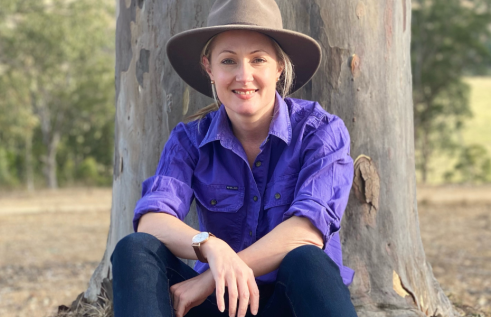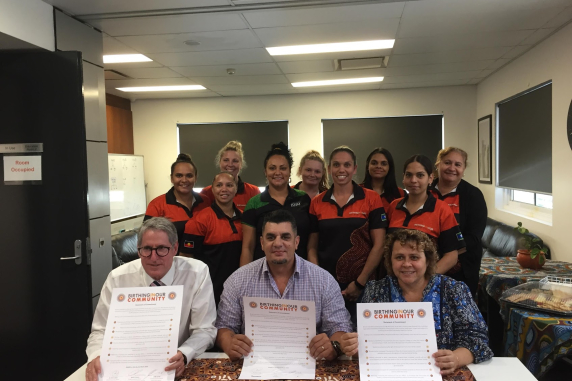Research impact
What does it take to improve Indigenous birth outcomes?
It’s not the norm for research projects to observe outcomes improved by 50 per cent. In fact, it’s quite unusual. But this is what CDU’s Indigenous Birthing in an Urban Setting (IBUS) research project has found. The results send a strong signal that the preterm birth gap can be reduced.
The study found that a maternity program for Indigenous families helped to halve preterm birth and improve many outcomes for Aboriginal and Torres Strait Islander mothers and babies in just five years.
“In Australia, the rate of preterm birth for Aboriginal and Torres Strait Islander mothers is almost double that of non-Indigenous mothers. This gap has not reduced over the last 10 years."
"In our urban setting in Brisbane, the rates were increasing and were in need of attention,” says Dr Sophie Hickey, project manager and an applied sociologist at CDU’s Molly Wardaguga Research Centre.
Reducing preterm birth is important, because an early arrival can impact the rest of an infant’s life. It is associated with stillbirth, infant mortality, disability in childhood, and chronic disease into adulthood.
“Not only can it be super stressful for families, preterm birth can also cause poor health and sometimes even lead to death. It’s also very expensive for families and uses lots of health funding in the short and longer term,” explains Dr Hickey.
Introducing a Birthing on Country service
With the backing of extensive community advocacy and consultation, the Birthing in Our Community Service was introduced. It is the result of a partnership between the Institute for Urban Indigenous Health, Aboriginal Torres Strait Island Community Health Service Brisbane, and the Mater Mothers Hospital.
The service seeks to re-design maternity care for women have Aboriginal and Torres Strait Islander babies in Brisbane South.
But does the Birthing in Our Community Service work? That’s exactly what Dr Hickey is trying to find out.
Her Indigenous Birthing in Urban Settings (IBUS) study is evaluating the service. The research team (includes Associate Professor Yvette Roe, Professor Sue Kildea, Associate Professor Yu Gao and Dr Sophie Hickey) are working closely with industry and have engaged with more than 600 Aboriginal and Torres Strait Islander families are involved.
The team analyse clinical data, and also look at the community’s perception and support for the Birthing in Our Community service. They feed their findings back into the service for continuous improvement.
Funding growth
The team’s early research results have been promising and, on the back of this, it’s been easier to secure additional funding to grow the Birthing in Our Country service.
Since the service’s launch in 2013, it has doubled its capacity and increased its Aboriginal and Torres Strait Islander workforce. It also provides transport to and from appointments. and cultural days at the community-based hub in Brisbane.
“It’s a bit rare in research to have the stars aligned to get such great outcomes. But it’s been a really passionate, motivated and committed team,” says Dr Hickey.
Community-led success
The program’s success is a direct result of community involvement and local Indigenous leadership, says Dr Hickey.
“The program was born to meet a need that the local Indigenous community identified as being important. Because of this, they’re really invested in it," Dr Hickey explains.
"That’s the big difference from many other programs; Birthing in Our Community has strong community buy-in and community leadership."
“In fact, Aboriginal and Torres Strait Islander staff working in the service grew by more than 500 per cent since its launch in 2013."
Put simply, if the community feels ownership of the program, the program is much more likely to be a success.
And the research team have shown that the community involvement and ownership is important for every stage of the program. From designing and implementing the program, to ensuring its long-term sustainability, to making it culturally safe and accessible.
New opportunities emerge
A five-year study has many challenges. Not least, the incredible about of data to be analysed!
Dr Hickey’s team are working with 10 years of clinical data from over 600 families at four different time points. That includes lengthy interviews and surveys.
But challenge is sometimes just another way to say opportunity.
From the Indigenous Birthing in an Urban Setting Study, two smaller research projects have emerged.
One worked with women who were smoking in pregnancy and were interested in getting support to quit. 56 Indigenous women joined the study and received intensive follow-up support. The research team would like to understand women’s experiences with receiving this support and whether it made an impact on smoking cessation.
The second project, led by Associate Professor Yu Gao, is a health economics sub-study. This study will undertake the cost-benefit analysis of the program, to understand how cost-effective it is in relation to the outcomes it achieves. We have an International PhD Position and Scholarship available for this project.
CDU is actively seeking higher degree by research students to join projects like these. Scholarships are available. Learn more.
Related Articles

Hannah found a passion for public health in the Kimberley
Read more about Hannah found a passion for public health in the KimberleyHannah’s time volunteering in a remote community in the Kimberley would inspire her to change gears in her career. Studying public health online at Charles Darwin University became the link to her future.

Lauren is the change she wants to see in rural pharmacy
Read more about Lauren is the change she wants to see in rural pharmacyBecoming a small-town pharmacist is a dream come true for Lauren, who has spent a lifetime involved in the health of her community. She just needed the right online program to support her goals.

Lana's following a fascination with the human body into a new career
Read more about Lana's following a fascination with the human body into a new careerAfter leaving the geoscience space to focus on raising her family, Lana felt that retraining was the way to get where she wanted to go professionally. Always fascinated by health and the human body, she discovered CDU's Bachelor of Health/Master of Occupational Therapy dual degree and never looked back.
